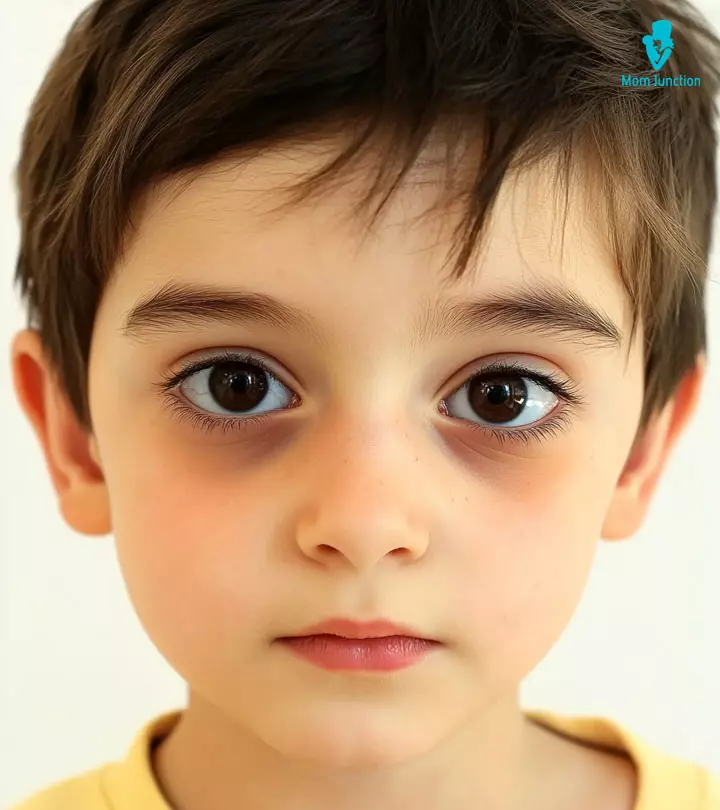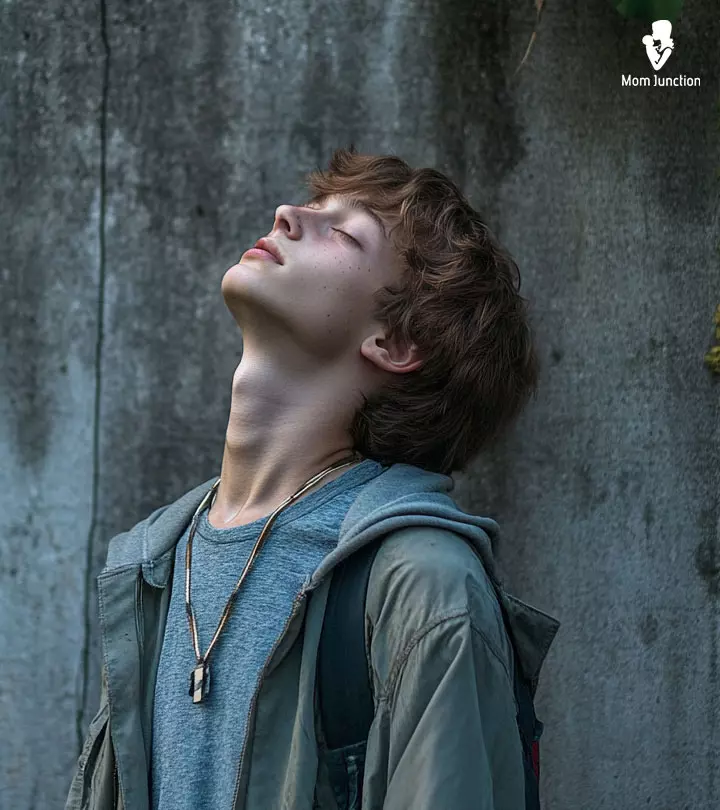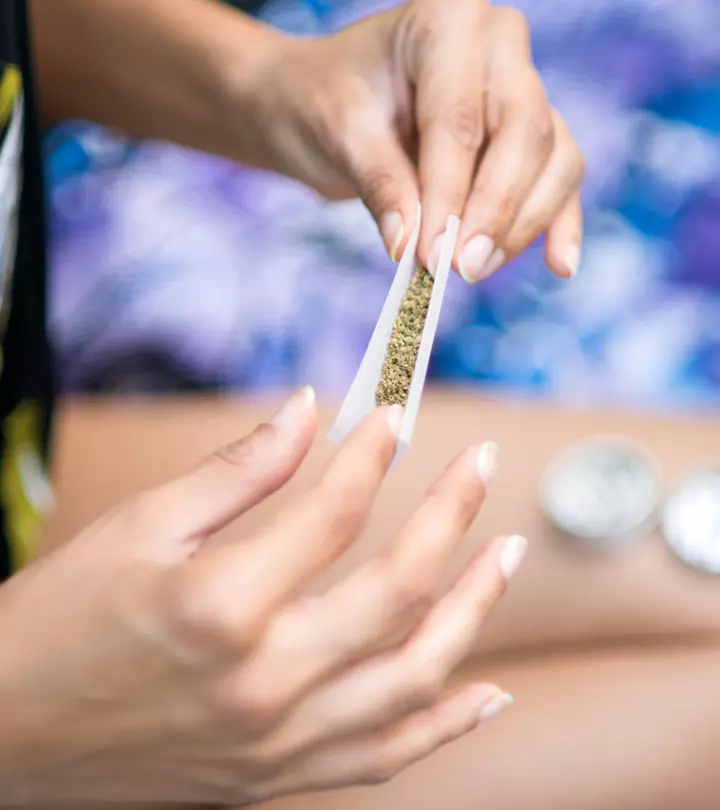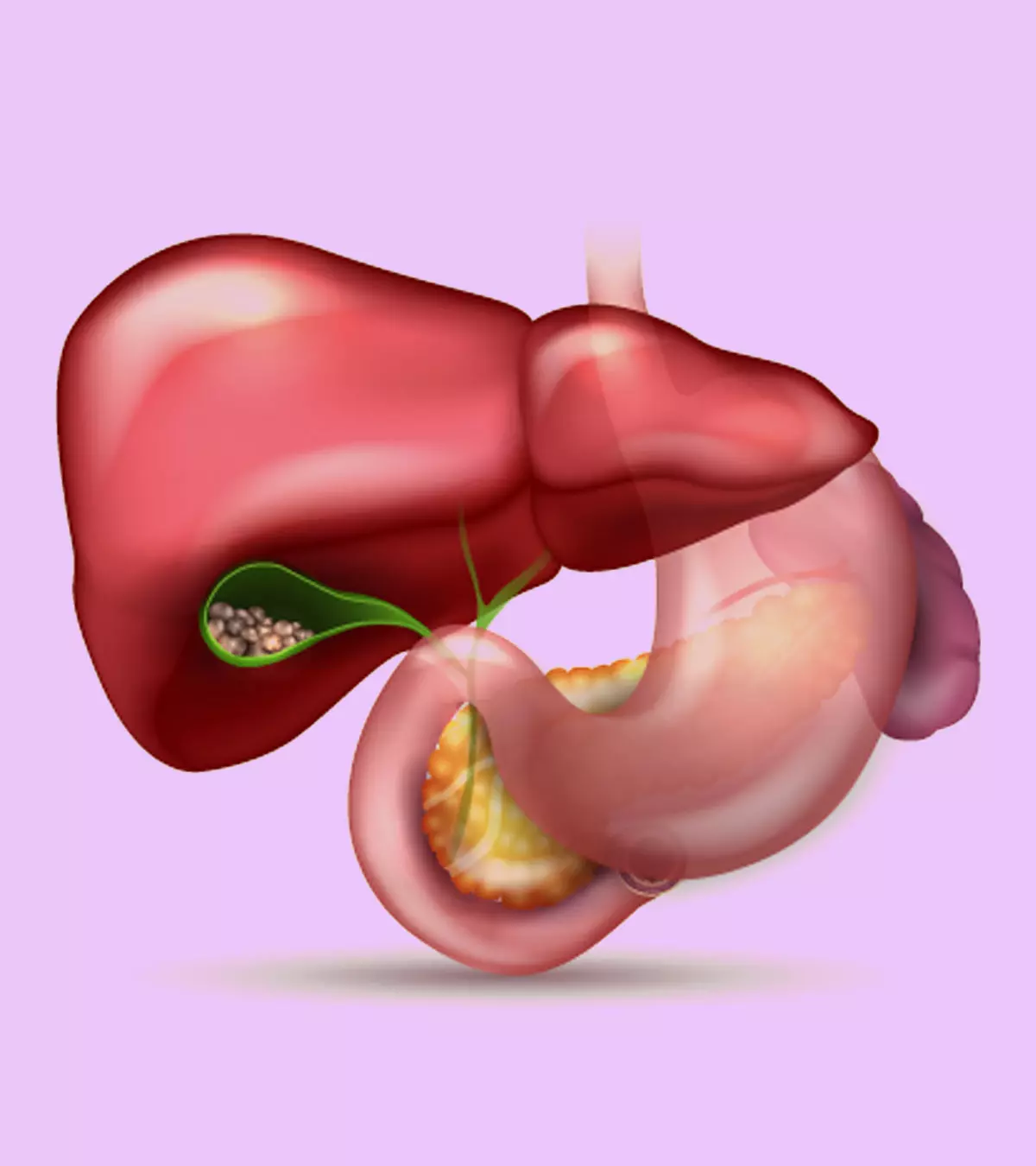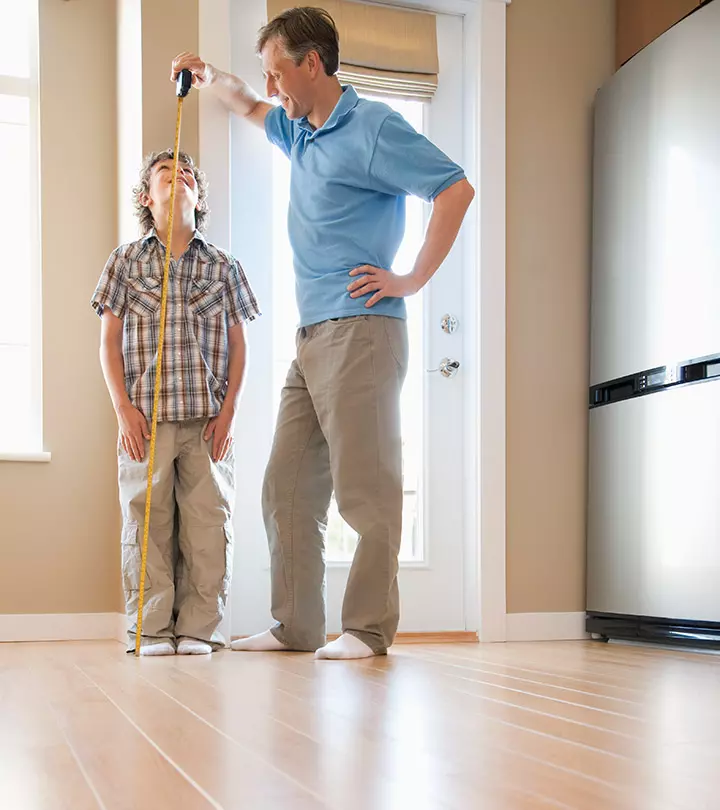
Image: MomJunction Design Team
Yoga poses for kids are a great way to induce calmness. According to studies, practicing yoga can let children have a stress-free and balanced life along with stable mental health (1). A meta-study by Rutgers University and The Yoga Way Therapy Center has found that yoga practice helped alleviate the symptoms of anxiety and depression in about 58% of the participants. Yoga is simple and one doesn’t need to be a master to practice it effectively. It is one of the best relaxation techniques for children. Encourage your children to make it a routine and a way of life to improve their concentration. This post tells you all you need to know about yoga for children, including its benefits and some easy poses to get them started.

Key Pointers
- Yoga is beneficial for children as it helps them relax and improves their physical health.
- It also helps reduce stress and improves sleep quality.
- Easy and beneficial yoga poses for children include the tree pose, cobra pose, and butterfly pose.
- It is advised that parents engage their children to practice yoga regularly and help them lead healthy lives.
Benefits Of Yoga For Kids
Yoga is a philosophy that teaches the ability to unite the physical, spiritual, and emotional aspects of a person using mindful movement and helps them to reach a state of inner peace (2). Yoga may be helpful while dealing with several physical and emotional problems. It could be used as a tool to bring balance to life.
Dr. Wendy Schofer, a board-certified pediatrician, lifestyle physician, and registered yoga teacher from Chesapeake, Virginia, says, “Yoga isn’t just a number of poses. It is truly a way of life and can be used at any age. Children can hold yoga poses for as long as they are comfortable. There is no role of deepening the stretch for children practicing yoga. The focus should be on enjoying the activity through calming, gentle movements, and playfulness. Yoga is safe when children listen to their bodies.
Infographic: What Are The Benefits Of Yoga For Children?
Some thing wrong with infographic shortcode. please verify shortcode syntax“Children should only participate in yoga poses that are based on their current body’s strengths. I strongly advise that headstands not be practiced by children, as it can be a risky pose.”
Here are some of the possible health benefits of yoga (1) (3) (4):
- Improves body balance, strength, and aerobic capacity
- Helps reduce chronic pain such as muscle pain
- Enhances the quality of sleep
- Can reduce the release of stress hormones like cortisone, and, therefore, is effective in reducing stress, anxiety, and fatigue
- Works on the child’s classroom behavior, focus, and academic performance
- Improves the quality of life by bringing emotional balance, since yoga is a non-competitive activity
- Helps children improve resilience, mood, and self-regulation skills
- Six months of yoga, including meditation, asanas, and pranayama (meditative breathing exercises), have shown to reduce body weight, improve endocrineiThe system of glands that secrete hormones directly into the blood functions and memory. All these are exercises for kids at home and can be practiced daily.
 Did you know?
Did you know?Why Kids Should Start Yoga Early
Starting yoga early in life is not only beneficial for children’s physical growth but also for their emotional and overall well-being. It helps children to develop interpersonal relationships, stress management, and mindfulness, skills that might be useful in their adulthood.
Yoga has innumerable benefits to offer. Let your kid start with the basic poses and realize the beauty of this practice. There are different styles of yoga, including body postures, breathing exercises, and meditation. So, while teaching yoga for kids, you may consider focusing on the movement and on how to make it interesting for them initially. Once you can get them interested, consider adding the children’s breathing exercises and child meditation.
How To Create The Ideal Yoga Environment For Kids
Yoga is a mindful activity that demands patience and focus. So, setting up the right environment to help children feel relaxed and open to the experience is essential. Here are some tips on creating the perfect atmosphere for your children to get started.
- Choose a comfortable place: For your child’s yoga practice, select a quiet and peaceful area in your home that is free from distractions. A cozy corner in the living room or even a grassy spot in the backyard can work well. Ensure the space is well-lit and ventilated.
- Create a peaceful environment: Yoga benefits both the mind and body. It can help your child feel calm and relaxed. Hence, the best place for yoga is outdoors in nature, but if that’s not possible, play calming music to create a peaceful atmosphere at home.
- Make it playful: Some yoga poses may seem difficult to children, but they can learn them quickly if the process seems fun. When teaching them asanas, use storytelling or animal-themed names for poses like ‘downward dog’ or ‘cat stretch.’ It will help them remember the poses.
- Keep the session short and simple: Start with easy poses and gradually move to more complex asanas. Avoid making your child hold a pose for too long, as they might lose interest and may not want to do any more poses.
- Join them in the practice: Instead of making your child practice yoga alone, join in on your child’s yoga sessions. It will inspire them to experiment with different poses, and you will have a blast challenging each other to master the more difficult ones.
- Let them learn at their own pace: Yoga should be a joyful experience, not a strict practice. Allow children to take breaks if needed and explore poses in their way. The goal of practicing yoga should be to cultivate a love for movement and mindfulness rather than striving for perfection in every pose.
Now that you know how you can create an engaging yoga environment, let’s learn about different yoga poses that children can practice with relative ease.
50 Easy And Relaxing Yoga Poses For Kids
Yoga doesn’t require a huge place or elaborate equipment. It can be performed in the garden, at home, or at school, with just a yoga mat. But before your children embark on their yoga journey, explain to them that the result is visible gradually over time. And to achieve this, they need to practice regularly. To begin with, here are a few easy yoga poses you can try teaching your children.
1. Bridge Pose (Setu Bandha Sarvangasana)
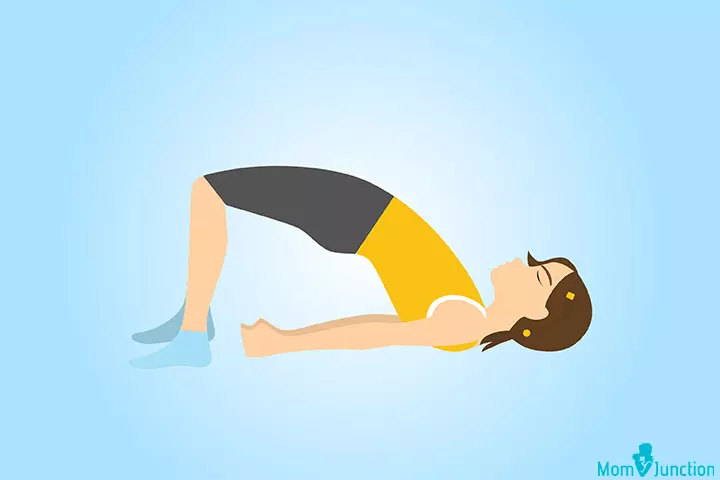
This rejuvenating backbend gives a good stretch to the spine and thighs.
How to do:
- Lie on the back.
- Bend the knees a little and keep the feet flat on the floor, hip-width apart.
- The knees and ankles must be in a straight line.
- Place the arms in a resting position beside the body, with the palms downwards.
- Take a deep breath and lift the lower, middle, and upper back off the floor.
- Balance the body in a way that the arms, shoulders, and feet support the body weight.
- Keep the buttocks tight.
- Have the fingers interlaced, and hands pushed to the ground to help lift the torso higher.
- Let your child hold this posture for as long as they are comfortable and breathe slowly while they are in the pose.
- Exhale and release.
Possible benefits: Stretches and opens the shoulders, thighs, hips, and chest portion; strengthens the back and hamstringiThe flexible tendons that stretch from the back of the thighs to the knees ; increases the flexibility of the spine
Caution: If your kid faces difficulty in making the pelvis lift from the floor, slide a sturdy bolster under their sacrumiA triangular bone situated between two hip bones in the lower back to rest their pelvis. In case of any neck or shoulder pain, take assistance from a professional to hone the steps.
2. Tree Pose (Vrksasana)
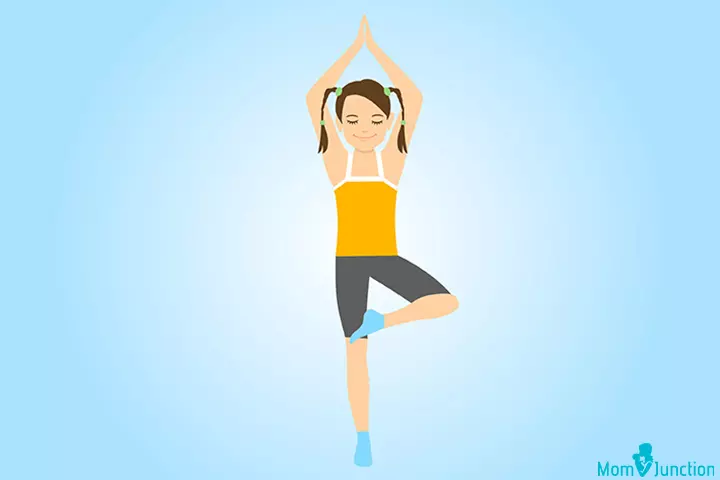
Vrksasana teaches your kid the grace of a tree, standing tall and maintaining balance.
How to do:
- Begin the posture with the mountain pose, wherein the legs are straight, hands at the sides, back straight, and thigh muscles firm.
- Lift the right foot with the knee out.
- Place the right foot on the left inner thigh in a position where it feels comfortable.
- Press the hands together above the head.
- Gaze at a point about five feet away.
- Hold the position for 30 seconds to a minute.
- Return the hands to the chest and then lower the right leg.
- Repeat it on the left leg.
Possible benefits: Improves balance and concentration; strengthens the thigh muscles, calves, and ankles while stretching the legs and the chest
Caution: If your kid gets unsteady in the beginning while trying to hold their posture, you may make them stand with their back against a wall.
3. Cobra Pose (Bhujangasana)
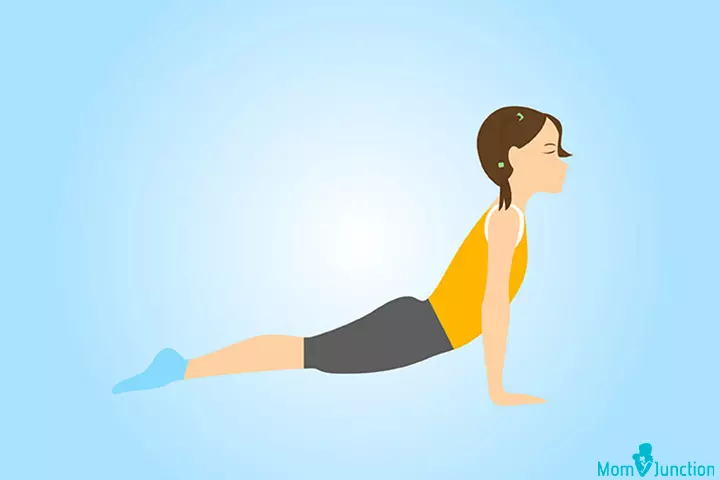
The stretch might promote a sturdy back, abs, and strength.
How to do:
- Lie face down with the tips of the feet flat on the floor and palms on either side of the body.
- Pull the shoulders slightly back towards the spine.
- Engage the abdomen throughout the exercise as it keeps the lower back protected.
- Lift the body into a cobra pose while keeping the chin up. Use the hands for support, but without putting unnecessary pressure.
- Hold the posture for 15 to 30 seconds, before gently releasing the body to the floor. This is a good, morning yoga pose for kids to practice daily.
Possible benefits: Strengthens the spine; stretches the chest, shoulders, abdomen, and buttocks; stimulates the abdominal organs and releases fatigue and stress; might be good for managing breathing problems like asthma.
Caution: Ask your kid to arch the back as much as the body can take. Since children’s flexibility can differ, let them take it easy.
4. Cat Pose (Marjaryasana)

The cat pose is a gentle kneading for the back and core.
How to do:
- Take a tabletop position using the hands and knees.
- The knees should be directly below their hips, and toes curled.
- The wrists, elbows, and shoulders should be straight and perpendicular to the floor.
- Center the head in a neutral position with eyes looking at the floor.
- With an exhalation, arch the spine up towards the ceiling.
- Release the head towards the floor without forcing the chin towards the chest.
- Come back to the initial tabletop position while inhaling slowly.
Possible benefits: Relaxes and stretches the spine, neck, torso, and the organs of the abdomen
Caution: If your kid faces difficulty while rounding their upper back, lay a hand above and between the shoulder blades for support.
5. Bow Pose (Dhanurasana)
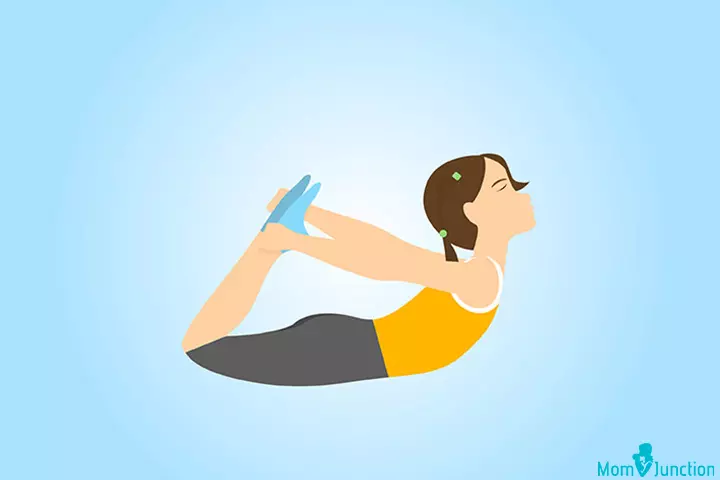
Bend the back like a bow and open the chest and shoulders with the bow pose.
How to do:
- Lie flat on the stomach, keeping the arms stretched along the sides of the body and head resting gently on the mat.
- Inhale and bend the knees bringing the feet towards the hips.
- Grasp the ankles using both the hands.
- Lift the shoulders, torso, legs, and hips off the floor while gazing straight ahead.
- Hold the posture for four to five breaths, then lower the knees and release the feet.
- Rest on the stomach.
Possible benefits: Stretches and strengthens the back, shoulders, chest, and legs; brings flexibility to hip flexor function, and regulates the digestive system
Caution: The bow pose involves a great deal of stretching, so if your child feels heavy in the lower back, keep the posture lower until it is comfortable to stretch. Help them in holding the ankles in step 3 and lifting the body in step 4.
6. Frog Pose (Mandukasana)

This pose might help in relieving sprains or back pains.
How to do:
- Start by going on the floor on the hands and knees.
- Position the knees a few inches apart and place the feet right behind the knees.
- Place the palms right under the shoulders with the fingers facing forward.
- Look downwards and focus at a point between your hands.
- Now, push the tailbone towards the back. This will stretch the spine. This position is known as the table position.
- Slowly move the knees outwards to the sides. Then align the ankles and feet with the knees in a straight line.
- Start to slide downwards while keeping the palms flat against the floor.
- Exhale and keep pushing the hips backwards until a stretch is felt.
- Now, hold this position for three to five breaths.
- Come back to the table position again.
Possible benefits: Stretches the hips, thighs, and spine
Caution: If it hurts your child under the knees or the elbows, place a folded blanket to provide support and strength. Let them not stretch beyond their comfort level.
7. Easy Pose (Sukhasana)
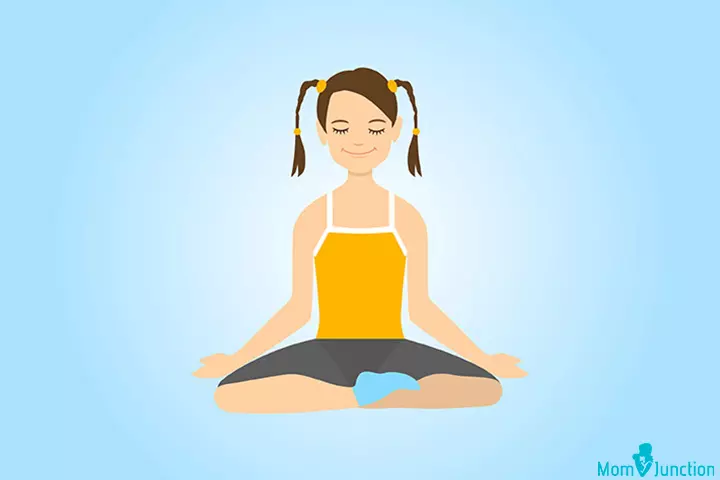
This is the simplest of all poses that the child can try.
How to do:
- Sit upright with legs crossed.
- Rest the hands on the knees with the palms facing up.
- Evenly balance the weight across the sit bones.
- Keep the head, neck, and spine aligned all along.
- Elongate the spine but without stiffing the neck.
- The feet and thighs should be relaxed.
- Retain this posture for a minute.
- Release and change the cross-legged position.
Possible benefits: Good for the back, thighs, and hips; gives a stretch to the knees and feet; and helps in negating anxiety and stress.
Caution: If your kid’s hips are tight and they are finding it difficult to sit flat, prop them up with a folded blanket or firm pillow under the hips.
8. Butterfly Pose (Baddha Konasana)
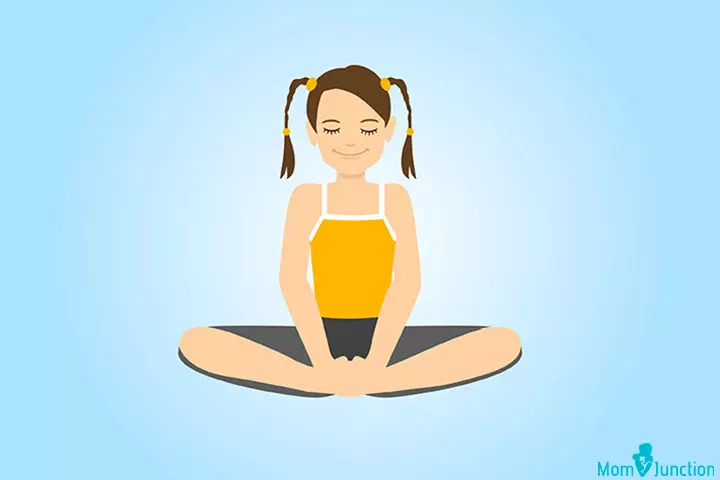
A pose that makes your kid flutter like a graceful butterfly, this is believed to offer some valuable benefits.
How to do:
- Sit with the spine upright and legs spread out straight.
- Fold the legs so that the feet are touching each other. Hold them with the hands.
- While exhaling, gently move the thighs and knees in a downward motion.
- Then start flapping the legs up and down, like the wings of a butterfly.
- The flapping should be slow initially and then pick up to speed. Breathing should be at a normal pace.
- Slow down gradually and then stop.
- Gently release the posture while exhaling.
Possible benefits: Stretches the thighs, knees, and hips; regulates the intestine and bowel movement; for girls, helps in easy and painless menstruation.
Caution: If your kid has a knee or groin injury, keep a blanket under the thighs to prevent pain or ache.
9. Corpse Pose (Savasana)

Though this yoga pose looks effortless, it could be challenging as it needs patience.
How to do:
- Lie on the back with legs straight and arms at the sides. The arms should be at a minimum distance of six inches away from the body.
- Keep the eyes closed, and palms faced upwards.
- Keep the feet drop open.
- Breathe normally while resting the body’s weight on the ground.
- Slowly exhale while relaxing and de-stressing all the body parts.
- This is the best relaxing yoga pose for kids.
Possible benefits: Keeps the heart rate and blood pressure low; less tension of muscles; low metabolic rate; helps reduce insomnia, anxiety, and fatigue; improves productivity, memory, and concentration.
Caution: Often, the body cools down, and one may feel relatively cold after holding this posture. Have a sweater or a pair of socks around your kid, in case they feel cold.
10. Chair pose (Utkatasana)
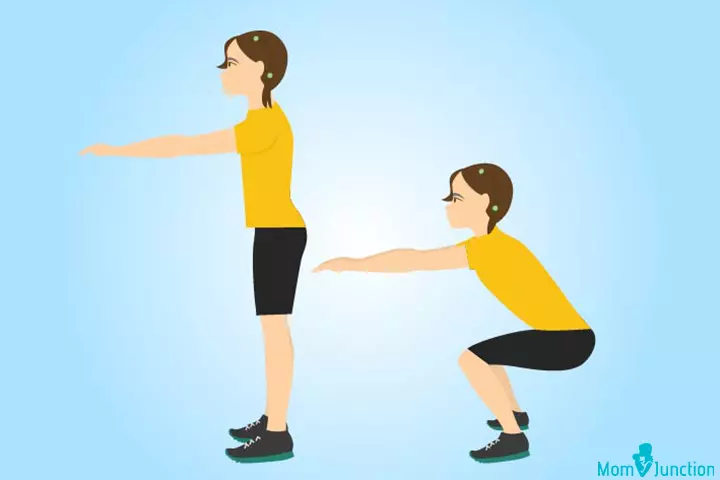
The chair post is a workout for the legs, arms, and the heart, and is believed to be one of the most constructive yoga poses.
How to do:
- Inhale and raise the arms above the head.
- Bend the knees forward while exhaling; the thighs should be parallel to the floor.
- While performing it, the knees will project slightly ahead.
- Lift your arms and stretch them straight.
- Keep the tailbone down and the lower back long.
- Keep the breath steady and easy throughout.
- Keep the gaze forward.
- Retain this posture for as long as comfortable, but not more than a minute.
Possible benefits: Works on the thigh muscles and ankles; tones the shoulders, hips, and the spine; regulates the digestive system and heart functioning.
Cautions: If your child is experiencing headaches or insomnia, do not perform this asana.
11. Hero Pose (Virasana)

This pose might be the salve for the weary legs of your kids.
How to do:
- Sit with the knees together and the feet hip-width apart.
- Sit on the heels with the heels touching the hips.
- The hands should rest on the knees with the palms facing up.
- Straighten the spine and drop the shoulders down and a little towards the back.
- Relax the core while taking deep breaths.
- Retain the posture for as long as it is comfortable.
Possible benefits: Stretches the spine, quadricepsiThe group of muscles in front of the thigh , and shoulders; improves blood circulation and relieves tiredness of legs; improves digestion and posture.
Caution: If the hips don’t rest comfortably on the yoga mat, use a yoga block in between.
12. Boat Pose (Naukasana)

This balancing yoga pose might help kids to de-stress and revitalize.
How to do:
- Lie down flat with feet aligned together and arms on the sides.
- Keep the arms and fingers outstretched in the direction of the toes.
- Inhale and while exhaling, lift the chest and feet off the ground, to form a ‘V’ shape.
- This will build tension and stretch in the core.
- The weight of the body will solely rest on the hips.
- The eyes, hands, and toes should align straight.
- Hold the breath and retain the posture for a few seconds.
- Exhale slowly while bringing the body down to the neutral position. And relax.
Possible benefits: Strengthens the core, arm muscles, shoulders, and thighs; it is great for the liver and kidneys; helps reduce constipation and alleviates digestive problems.
Caution: If your kid suffers from any chronic disease or spinal cord problems, avoid the pose.
13. Mountain Pose (Tadasana)
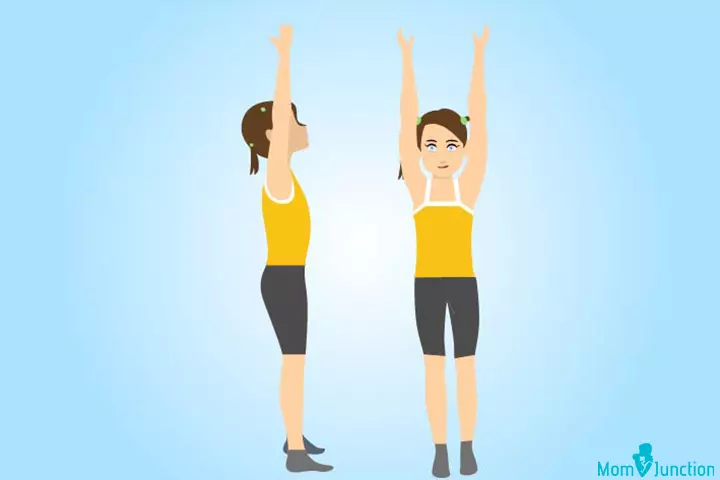
This is a foundational pose for all the standing asanas and could be a calm-down yoga pose for children.
How to do:
- Stand straight and tall.
- Spread the legs a few inches apart and spread the toes.
- Keep the arms alongside the body.
- The shoulders must be relaxed and not stiff.
- Raise the arms above your head.
- Hold the posture and breathe slowly.
- Retain as long as comfortable.
Possible benefits: Improves posture, strengthens the thighs, legs, and ankles; firms the abdomen and hips; improves sleep
Caution: No cautions to follow up.
 Quick tip
Quick tip14. Happy Baby Pose (Ananda Balasana)

This asana might help relax the back joints.
How to do:
- Lie on the back with the knees drawn in towards the chest.
- Hold the feet with your hands. Ensure that the arms are in front of the torso.
- Draw the shoulders to the back.
- Slightly stretch the arms and feet.
- Draw the knees wide apart, as much as comfortable.
- Elongate the lower back down to the ground while touching the tip of the tailbone.
- Retain the position for a minute or less, and then release.
Possible benefits: Stretches and opens the hips, thighs and inner groin; elongates the spine; strengthens the arms and shoulders
Caution: If your kid has any knee or ankle injury, check with a doctor before performing this pose.
15. Lion Pose (Simhasana)
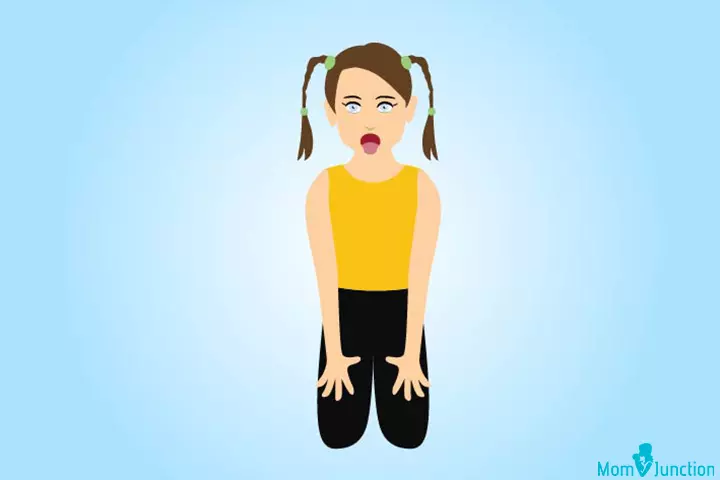
Might help your child de-stress with this animal asana; have them roar and enjoy.
How to do:
- Sit with the hips on the heels.
- Rest the palms on the knees.
- Start inhaling from the nose, and while you’re on it, stick your tongue out.
- Keep the eyes wide open, exhale through the mouth, and make a sound of a roaring lion (Haaa).
- Many yoga schools suggest that you either concentrate looking at the tip of the nose or in the middle of the eyebrows.
Possible benefits: A great yoga stretch for the lungs, throat, and the respiratory tract; regulates the functioning of the tonsils and the immune system; reduces stress, anger, and anxiety; suitable for a hyperactive child.
Caution: Do not repeat this for more than five times.
16. Warrior II Pose (Virabhadrasana)
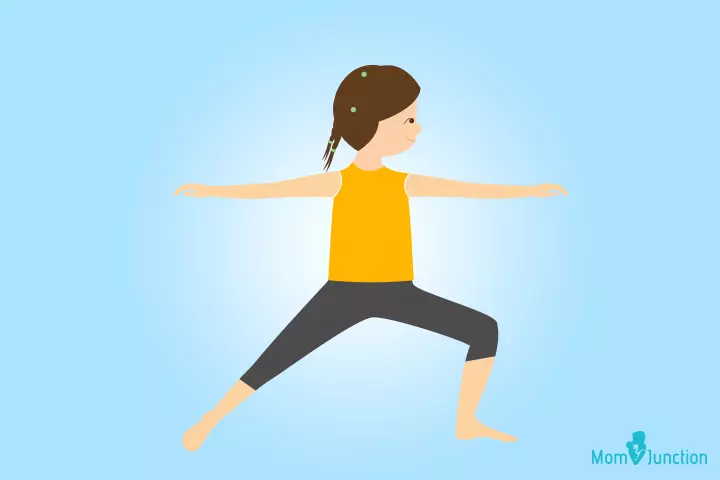
One among the warrior poses, this pose is perfect for stretching the hips and building strength. If your little one likes such postures, you may teach other stretching exercises for children as well.
How to do:
- Begin in a standing position at the top of your mat, feet hip-width apart.
- Step your left foot back, keeping it about three to four feet behind your right foot.
- Turn your left foot slightly inward, aiming for a 45-degree angle, while keeping your right foot pointing forward.
- Bend your right knee, ensuring it aligns directly above your right ankle. Your thigh should be parallel to the ground.
- Extend your arms out to the sides, parallel to the floor, with palms facing down.
- Keep your torso facing forward and gaze over your right fingertips.
- Relax your shoulders, reaching through your fingertips while keeping them in line with your shoulders.
- Engage your core muscles and lengthen your spine.
- Hold the pose, breathing deeply, for 30 seconds to one minute.
- To release, straighten your right leg, turn your feet to face forward, and return to a standing position.
- Repeat the steps on the other side by switching the position of your feet.
Possible benefits: This pose helps build strength, balance, flexibility, and focus. This pose targets the neck, shoulder, chest, hips, and ankles.
17. Standing Forward Bend (Hastapadasana)
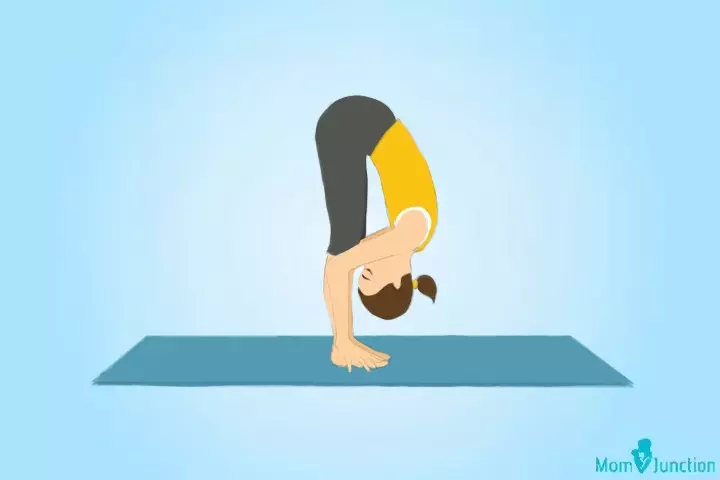
The invigorating forward bend provides a good stretch to the muscles along the back of the body.
How to do:
- Stand tall with your feet together and arms resting by your sides.
- Distribute your weight evenly on both feet.
- Inhale deeply and extend your arms upward.
- Exhale slowly as you bend forward, reaching towards your feet.
- Stay in this position for 20-30 seconds, breathing deeply throughout.
- Ensure your legs and spine remain straight; place your hands on the floor beside your feet or on your legs.
- As you exhale, move your chest closer to your knees, lift your hips and tailbone higher, press your heels down, and relax your head gently towards your feet.
- Breathe in and stretch your arms forward and up, then slowly return to a standing position.
- Exhale and bring your arms back to your sides.
Possible benefits: Stretches the back of the body, including the spine and legs; invigorates the nervous system by boosting blood flow; increases spinal flexibility; tones abdominal organs.
Caution: Kids with lower back injuries, spondylitis, cervical pain, or any similar issues should avoid this pose.
18. Eagle Pose (Garudasana)

This engaging pose enhances balance while stretching the hips, shoulders, and upper back, making it a fun challenge for kids.
How to do:
- Begin by standing upright with feet together and arms relaxed at the sides.
- Bend the left knee and lift the left foot, then wrap it around the right leg so the left thigh rests on the right thigh.
- Cross the arms at the elbows, placing the left arm over the right.
- Press the palms together with fingers pointing upward.
- Inhale deeply and maintain the pose while holding your breath.
- Exhale as you return to the starting position.
- Repeat on the opposite side, this time wrapping the right leg over the left and the right arm over the left.
Possible benefits: Improves balance and stretches the hips, shoulders, thighs, and upper back; strengthens the calves; enhances flexibility in the legs and hips; may help alleviate sciatica and rheumatism.
Caution: Avoid this pose if your child has any recent injuries to the ankle, knee, or elbow.
19. Downward Facing Dog Pose (Adho Mukha Svanasana)

This energizing pose refreshes the body and mind, providing an excellent full-body stretch.
How to do:
- Start on all fours, positioning yourself like a table, with your back forming the tabletop and your hands and feet acting as the table legs.
- Breathe out and lift your hips up, straightening your knees and elbows to form an inverted V-shape with your body.
- Ensure your hands are shoulder-width apart and your feet are hip-width apart, with toes pointing straight ahead.
- Press your hands firmly into the ground, widening through the shoulder blades. Keep your neck long by aligning your ears with your inner arms.
- Hold the Downward Dog pose, taking deep, slow breaths, and look towards your navel.
- To release, exhale, bend your knees, and return to the tabletop position.
Possible benefits: Energizes and rejuvenates the body; lengthens the spine; strengthens the body; tones muscles; boosts circulation to the brain; helps in calming the mind.
Caution: Children should avoid this pose if they have high blood pressure, carpal tunnel, eye issues, shoulder injuries, or diarrhea.
20. Dancing Shiva Pose (Parivrtta Hasta Padangusthasana)

This challenging pose is a fantastic way for kids to explore balance and strength while stretching their bodies.
How to do:
- Start in mountain pose, standing tall with feet together.
- Shift your weight onto your left leg.
- Lift your right leg up, holding the knee with your left hand for balance.
- Begin twisting your torso towards the lifted leg, extending your right arm behind you.
- Gaze over your right shoulder towards your right thumb for focus.
- If possible, reach your right hand to grasp your right foot’s big toe.
- With each exhale, gently deepen your twist.
- Hold the pose for five slow breaths.
- Repeat on the opposite side.
Possible benefits: Enhances balance and concentration; strengthens the legs and core muscles; stretches the hamstrings and IT band; opens the chest for better posture; energizes the body and mind; improves flexibility in the spine.
Caution: Avoid if your child has hip or lower back issues, or any recent injuries to the ankles, knees, or shoulders. Also, ensure proper guidance to avoid strain and encourage correct alignment, especially for younger practitioners.
21. Upward Facing Dog Pose (Urdhva Mukha Svanasana)

This yoga posture involves bending the back to strengthen the spine and stretch the body.
How to do:
- Begin by lying flat on your stomach with your toes pointing downwards.
- Extend your arms down beside your body.
- Bend your elbows and place your palms next to your lowest rib.
- Inhale deeply and press firmly into your palms to lift your torso, hips, and knees off the mat.
- Balance your weight evenly between your palms and the tops of your feet.
- You can gaze straight ahead or slightly tilt your head backward.
- Ensure your wrists are aligned with your shoulders and avoid straining your neck.
- Hold the pose for a few breaths.
- Exhale slowly and lower your knees, hips, and torso back to the mat.
Possible benefits: Stretches and strengthens the back, alleviating lower back pain; strengthens arms; improves posture and stimulates abdominal organs.
Contraindications: Avoid this pose if you have Carpal Tunnel Syndrome or a back injury worsened by back extension.
22. Warrior III Pose (Virabhadrasana 3)

This challenging posture helps build strength and balance in children.
How to do:
- Begin by standing with your feet together.
- Place your hands on your hips.
- Shift your weight onto your left leg.
- Inhale deeply as you slowly lift your right leg straight back and simultaneously lean your upper body forward towards the floor.
- Continue lifting your leg and bending forward until your right leg and upper body are parallel to the ground. If balancing is difficult, stay at a comfortable level and progress gradually each day.
- Once in position, extend your arms straight forward to create a single straight line with your body. Keep your palms facing each other and fingers spread wide.
- Keep both legs straight and hips level with the ground.
- Hold the pose for 3-5 breaths.
- Exhale and return to standing position. Repeat on the opposite leg.
Possible benefits: Strengthens the shoulders, hips, back, thighs, knees, legs, and ankles; improves balance, focus, and coordination; tones core muscles.
Caution: Not suitable for children with high blood pressure. Children with medical issues should practice under adult supervision.
23. Table Top Pose (Bharmanasana)

This pose is ideal for introducing balance and gentle stretching to children. This pose evenly stretches all muscles while promoting body equilibrium.
How to do it:
- Begin on your hands and knees.
- Keep your knees hip-width apart and directly beneath the hips.
- Keep feet parallel to the knees and avoid overextending them.
- Place palms firmly on the ground directly under the shoulders, fingers pointing forward.
- Maintain a flat back and hold that position for a few counts.
Possible benefits: Stretches the wrists, arms, shoulders, core, spine, hips, thighs, and knees; relieves tension.
Caution: If there is any discomfort or strain in the wrists or knees, suggest padding or adjusting hand and knee placement. For those with existing wrist or knee issues, consulting with a yoga instructor or healthcare professional for modifications is advisable to prevent injury.
24. Flower Pose (Vikasitakamalasana)

This soothing hip-opener with an added balance element helps in building core strength and focus.
How to do:
- Begin in a comfortable seated position.
- Bend your knees and bring the soles of your feet together.
- Roll your outer thighs downward to open your hips and sit up tall.
- Slide your hands under your ankles through the diamond shape formed by your legs, palms facing upward.
- Lift your legs off the floor, balancing on your seat bones.
- Maintain a long spine and engage your core muscles.
- Relax your neck, shoulders, and face.
Possible benefits: Enhances posture; stretches and strengthens the back, groins, inner thighs, and ankles.
Caution: If it’s difficult to sit tall in this pose, place a blanket under your hips to create more space and gently open the hips. If you experience discomfort in your knees, alleviate the pressure by placing blocks under the outer thighs.
25. Sun Salutation (Surya Namaskar)
The Sun Salutation is a series of yoga poses that is performed one after the other to create a warm-up routine. It’s not only beneficial for physical health but also a fun way for children to engage in exercise and mindfulness.
How to do:
- Stand tall like a mountain with your arms at your sides (Mountain Pose).
- Reach both arms overhead to the sky (Tall Mountain Pose).
- Fold forward at the hips, encouraging your child to tickle their toes or yours (Standing Forward Bend Pose). It’s okay to bend the knees if needed.
- Step one leg back (traditionally the right leg) into a lunge, with the front knee bent at a right angle (Lunge Pose).
- From the lunge, step the front leg back to form an inverted “V” shape (Downward Facing Dog Pose).
- Transition from Downward Dog to a tabletop position and then lower onto your belly (Tabletop Pose).
- Place hands under shoulders, elbows tucked in, and lift the upper body like a snake (Cobra Pose).
- From Cobra, return to Tabletop and then back to Downward Dog.
- Step the right leg forward into a lunge.
- From the Lunge Pose, step the back leg forward to meet the front leg.
- Reach arms overhead again.
- Return arms to your sides or to prayer hands at your heart center (Anjali Mudra).
Possible benefits: Improved concentration and attention; enhanced balance and coordination; better emotional regulation.
Caution: Avoid pushing into any pose that causes discomfort and use props like bolsters for additional support if needed. Always seek professional guidance if there are concerns about specific poses or transitions.
26. Elephant Pose (Gaja Vadivu)

This playful pose is perfect for kids to imitate an elephant’s movements, blending fun with physical exercise.
How to do:
- Stand up straight with your feet positioned slightly wider than shoulder-width apart.
- Extend your left arm across to the right and gently clasp your nose with your right hand.
- Lean forward and begin swaying from side to side, mimicking the movement of an elephant. Children can walk across the room like this if preferred.
- Ensure your knees remain relaxed and soft while you sway from side to side.
- Enjoy the stretch, then gradually release your hands and return to a standing position.
Possible benefits: Relaxes and stretches the muscles in the shoulders, neck, and upper body. De-stresses and energizes while promoting awareness and concentration.
Caution: Those with shoulder or knee injuries should avoid this pose. People with weak joints and body frames are also advised not to perform this exercise.
27. Mouse Pose (Balasana or Shishuasana)

This delightful and soothing pose helps children feel secure and can aid in calming an overactive mind by drawing attention to their breath.
How to do:
- Start by sitting on your heels.
- Lean forward, keeping your hips touching your heels, and lower your forehead gently to the floor.
- Position your arms alongside your body with hands resting on the floor, palms facing upwards. (If this is uncomfortable, place one fist on top of the other and rest your forehead on them.)
- Softly press your chest down onto your thighs.
- Maintain this position and focus on your breath.
- To release, slowly roll up to sit back on your heels, uncurling your spine one vertebra at a time, and relax.
Possible benefits: Deeply relaxes the back; alleviates constipation; calms the nervous system.
Caution: Avoid this pose if your child has serious back or knee injuries.
28. Cat-Cow Pose (Marjaryasana-Bitilasana)

This animal-based flowing movement helps stretch the torso and neck. This pose can be made more by Incorporating a ‘moo’ or ‘meow’ sound.
How to do:
- Start on hands and knees with wrists aligned under the shoulders and knees positioned under the hips.
- Inhale deeply, allowing the belly to soften toward the floor and gently arching the back, lifting the tailbone and chin upwards; direct your gaze toward the ceiling.
- Exhale, rounding the spine as you tuck the chin toward the chest.
- Continue alternating these movements for a total of five breaths.
Possible benefits: Stretches the lower back and neck; improves concentration; decompresses the spine.
Caution: Children with neck or wrist injuries should refrain from performing this pose.
29. Crescent Moon Pose (Indudalasana)

This side stretch benefits the entire body by engaging the core and enhancing balance.
How to do:
- Start by standing tall in Mountain Pose (Tadasana).
- Inhale deeply and open the arms wide as if giving a hug, sweeping them upwards towards the ceiling until the hands meet at the top.
- Exhale and pause briefly.
- On the next inhale, extend the palms upward, directing them towards the sky while allowing the shoulders to relax away from the ears.
- Exhale and bend at the waist to the right, ensuring the arms, head, shoulders, hips, and feet remain aligned in a single plane, with feet firmly rooted to the ground.
- Inhale to return to the center with arms still extended skyward.
- Exhale and bend at the waist to the left side.
- Repeat steps 4-7 for 3-4 cycles on each side, ensuring smooth transitions guided by deep belly breathing.
- Finish the practice by returning to Mountain Pose.
Possible benefits: Stretches the sides of the body and strengthens the core muscles; enhances balance; improves concentration and supports circulation.
Caution: Avoid this pose if there is an injury to the hip joint, ankle, or shoulders, as holding this position may exacerbate pain and stiffness. Additionally, individuals who have undergone surgery on the spine, hip, knee, or ankle should refrain from this pose due to the pressure it places on these joints.
30. Dancing Ganesha Pose

This fun pose encourages balance and coordination by mimicking the trunk of Ganesha, the elephant god.
How to do:
- Begin in Tree Pose.
- Gently release the right foot and extend it forward, keeping the right knee bent.
- Stretch the arms out in front, positioning the hands as if forming an elephant’s trunk.
- Let your child hold this pose while maintaining balance and breathe slowly.
- Return to the starting position.
Possible benefits: Enhances balance and coordination.
Caution: No specific cautions for this pose.
31. Dolphin Pose (Catur Svanasana)
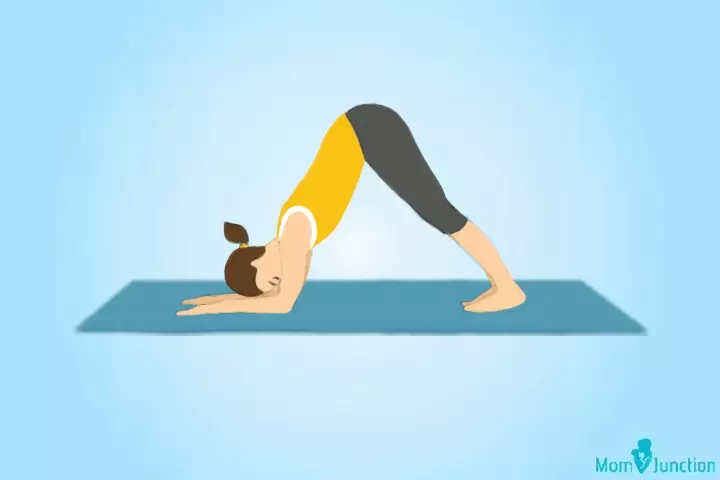
This strengthening pose serves as an excellent alternative to Downward Dog, especially for sensitive wrists.
How to do:
- Start on all fours, positioning your forearms on the floor with elbows directly under your shoulders.
- Place your palms flat on the ground with forearms parallel, or interlace your fingers, tucking in the bottom little finger.
- As you exhale, curl your toes under, engage your lower belly, and lift your knees off the floor.
- Raise your hips toward the ceiling, extending your tailbone, straightening your legs, and lowering your heels towards the ground. Note: Heels don’t need to touch the floor.
- Activate your thigh muscles and draw in your lower belly. Press your forearms firmly into the floor.
- Firm your shoulder blades onto your back while maintaining space between them. Lengthen your spine and keep your head between your arms, off the floor.
- Stay in the pose for 5 breaths.
- To exit the pose, lower your knees to the floor on an exhale and rest in Child’s Pose.
Possible benefits: Strengthens the arms, shoulders, upper body, and legs; activates the arches of the feet.
Caution: Avoid this pose if you have shoulder injuries.
32. Extended Child’s Pose (Utthita Balasana)

This relaxing variation of Child’s Pose adds a deep stretch to the shoulders and enhances the restorative benefits.
How to do:
- Start in the traditional Child’s Pose.
- Rather than keeping the arms by the sides, extend them forward to the edge of your mat with palms flat.
- Tilt your hips backward towards your heels and relax your upper body, letting your chest, shoulders, and torso sink closer to the floor.
- Let your shoulders droop away from your ears, releasing any tension in the shoulders, neck, and upper back.
- To exit, bring your arms back by your sides, and then return to the standard Child’s Pose position.
Possible benefits: Deepens the shoulder stretch; reduces tension in the neck and upper back; promotes relaxation.
Caution: Ensure your child moves slowly and mindfully to avoid overstretching. If they experience any discomfort, have them come out of the pose immediately.
33. Extended Cat Pose (Utthita Marjaryasana)

This balancing pose strengthens the core and elongates the spine.
How to do:
- Begin in a tabletop position, with the hands aligned under the shoulders and the knees directly under the hips.
- Lift one leg off the floor, extending it straight back.
- Simultaneously, extend the opposite arm forward.
- Keep the gaze down, ensuring the neck remains aligned with the spine.
- Encourage your child to maintain balance and stability while holding the pose for several breaths.
- Repeat on the other side, with the other leg and arm extended.
Possible benefits: Enhances balance, lengthens the spine, and improves focus, attention, and memory. It also alleviates stress, tension, and fatigue.
Caution: If children find balancing challenging, assist them or use props to provide support. Avoid this pose if your child has any recent or chronic back injuries.
34. Sailboat Pose/Extended Side Angle Pose (Utthita Parsvakonasana)
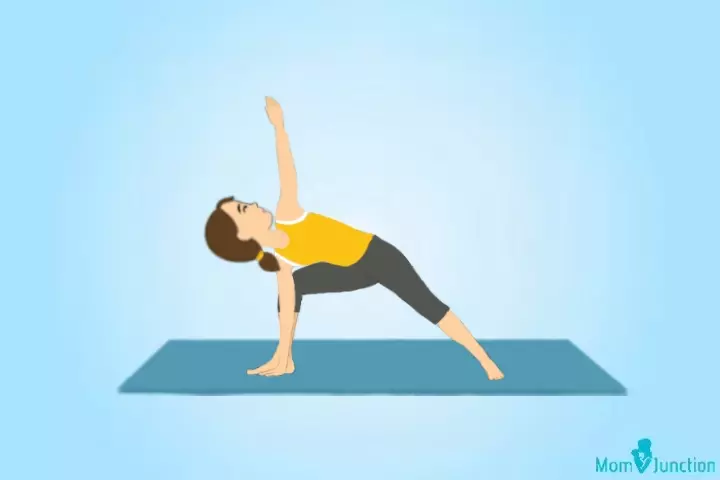
This side stretch mimics the graceful movement of a sailboat gliding through water while helping to strengthen and stretch various parts of the body.
How to do:
- Start in a standing position.
- Step one foot back slightly, angling your toe outward.
- Extend your arms parallel to the floor.
- Bend at the waist and tilt your upper body to the side.
- Gently rest your front hand on your shin.
- Reach your other arm straight up toward the sky.
- Imagine you are a sailboat catching the wind.
- Switch sides and repeat the steps.
Possible benefits: Strengthens the legs; improves flexibility of joints; enhances overall muscle strength; soothes and tones the abdominal muscles, aiding digestion.
Caution: Not suitable for children with weak nervous systems or fragile joints. The pressure on the joints may cause incomplete postures or lead to injury if not done correctly.
35. Gyan Mudra
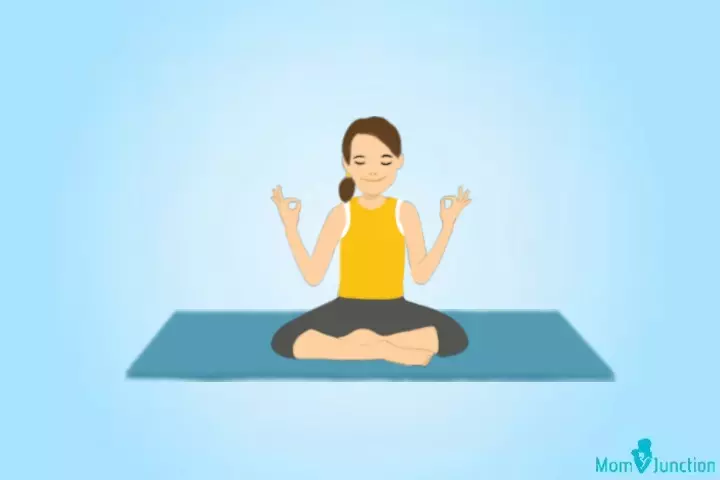
Gyan Mudra, also known as the Mudra of Knowledge or Wisdom, is a beneficial hand gesture that promotes mental clarity and focus.
How to do:
- Start by sitting in a comfortable meditation position with your neck and spine comfortably straight.
- Place your hands on your knees, keeping your palms facing upward towards the sky.
- Gently touch the tip of your thumb to the tip of your index finger, forming a circle in both hands.
- Keep the remaining three fingers comfortably extended.
- Close your eyes softly.
- Focus on your breathing, taking deep breaths.
Possible benefits: Improves focus, mental strength, and concentration; enhances memory; boosts nervous system and pituitary gland function; promotes stability during meditation practices
Caution: Supervision may be needed to correct the gesture gently and ensure they focus on their breathing while maintaining the mudra.
36. Half Shoulder Stand Pose (Ardha Sarvangasana)
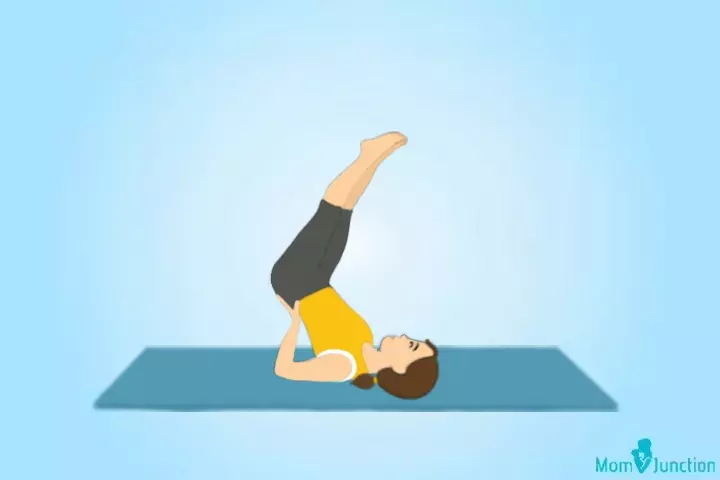
This calming yoga pose plays an important role in energizing the immune system.
How to do:
- Lie down on the back with arms resting alongside the body, palms facing down.
- Bend the knees and kick the legs up and over, bringing the knees close to the forehead. Place the hands under your hips for support.
Cup the hips and slowly start lifting the legs upwards, straightening them over your head. Use the arms and shoulders to support the - body’s weight, keeping minimal or no pressure on your head and neck.
- Find a position where the legs are balanced over your head, allowing the leg muscles to relax with as little effort as possible to stay still.
- Breathe deeply and hold this position for 4-10 breaths.
- To come out of the pose, bend the knees back towards the head and gently roll the spine back onto the floor. Breathe and hold for 2-4 breaths.
Possible benefits: Enhances blood and lymph circulation; stimulates the thyroid gland; activates the immune system.
Caution: Avoid this pose if there is a recent or chronic injury or inflammation in the neck, shoulder, or back.
37. Horse Stance Pose (Vatayanasana)
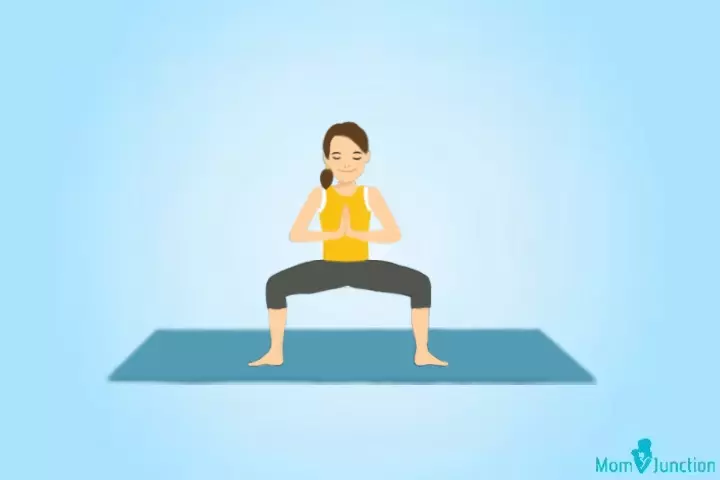
This fun and dynamic pose helps build strength and improves hip mobility in children.
How to do:
- Position the feet about 3 to 4 feet apart.
- Angle the toes outward (45 degrees minimum).
- Place hands on hips.
- Lower into a squat by bending the hips and knees, pressing the knees outward.
- Tighten the gluteal muscles, lower the tailbone, and press the pelvis forward to keep the hips aligned under the torso.
- Align the knees by keeping them tracking over the middle toes.
- Lift the arms and bend the elbows to about 90 degrees, with palms facing forward.
- Inhale to lengthen the tailbone down and keep the spine neutral; exhale to deepen the squat.
- Maintain the posture for a few breaths.
Possible benefits: Strengthens the lower body; improves hip mobility to prevent injuries; increases range of motion.
Caution: If the arches of the feet collapse, remind your child to press firmly into the toes and balls of their feet for better stability. In case of medical injury, refrain from performing this pose.
38. Kneeling Pose

This foundational pose serves as the basis for most kneeling yoga positions and helps warm up the body for more advanced poses and flows.
How to do:
- Sit on the floor with your legs extended straight in front of you. Adjust your seating to ensure you are positioned on your seatbones.
- Keep your legs together and your hands by the side of your body.
- Inhale, bend your right knee, and place your right foot close to your buttocks. Exhale.
- Inhale again, lift your buttocks off the floor, and position your right foot below your right buttock. Sit on your right foot as you exhale.
- Repeat this step with the left leg.
- Inhale and rise onto your knees, lifting your body away from your heels. Maintain a straight back.
- Stand tall on your knees with your hands by your sides. Remain in this position for about six slow, deep breaths or as long as comfortable.
- Ensure the knees and feet are together, with feet flat, aligning knees and ankles in a straight line.
- Continue breathing, keeping your stomach tucked, core strong, spine lengthened, chin slightly tucked in, and facial muscles relaxed.
- Take a deep breath, and while exhaling, lower your hips back onto your heels into Vajrasana.
- Tilt your body to the left to extend your right leg out in front, and then do the same with the left leg by tilting to the right.
- Sit by stretching your legs out in front of you.
- Relax by shaking or rotating your ankles.
Possible benefits: Strengthens the spine, lower abdominal muscles, pelvic floor, and knees; promotes breath awareness and chest stability; enhances overall posture.
Caution: Avoid this pose if your child has knee, ankle, lower back, or leg injuries, or has had recent abdominal surgery. Always ensure their knees are healthy and strong before attempting this pose.
39. Riding a Bike/Cycling Pose (Pada Sanchalanasana)

This fun and engaging pose mimics the motion of cycling, promoting agility and coordination in kids.
How to do:
- Lie flat on your back, with both legs together and your arms by your sides, palms facing down. Keep your head flat on the mat.
- Start with the right leg. Lift it without disturbing the left leg.
- Bend the right knee, bringing the thigh towards your chest.
- Extend the right leg to a 90-degree angle, pointing the toes towards you, and simultaneously lift the left leg off the floor to a 10-degree angle.
- As you lower the right leg, straighten it and bring it down to almost 10 degrees off the floor. At the same time, lift the left leg and bend the knee, bringing it towards your chest.
- Ensure that the heels do not touch the floor during the movement. Repeat this cyclical motion, coordinating your breath—inhale to lift and exhale to lower.
- Continue this cycling pattern 5-10 times in a forward direction, then switch and repeat the movement in the reverse direction.
- Relax by stretching your legs in the Corpse Pose (Savasana) for a few breaths.
Possible benefits: Enhances flexibility and joint mobility; strengthens abdominal and core muscles; boosts blood circulation; revitalizes the digestive system; reduces stress and promotes mental relaxation; improves focus and concentration.
Caution: Kids with knee or hip injuries should practice with caution and consult a yoga instructor or healthcare professional, if needed. If there’s any strain in the lower back, slow down or reduce the range of leg movements. You can place hands under the lower back or buttocks for extra support.
40. Canyon Wall Pose (Viparita Karani)
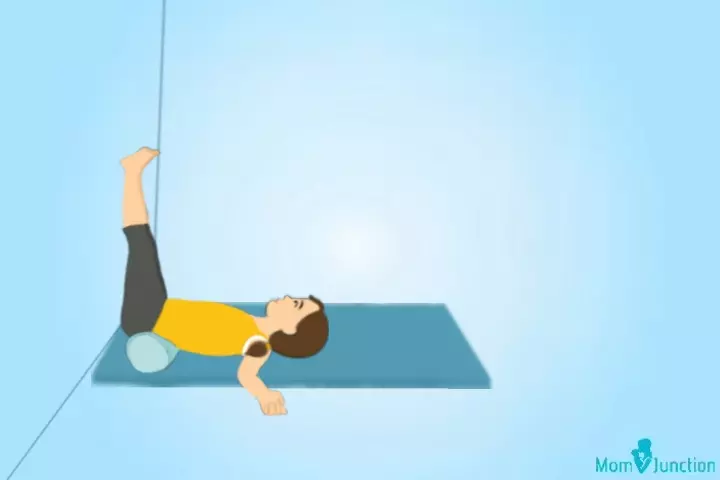
This calming pose may help kids by relaxing muscles, reducing swelling, and soothing the nervous system.
How to do:
- Find a clear wall space free of things and decorations.
- Sit down close to the wall with your right hip touching it and your knees bent, feet flat on the ground.
- Place your hands on the floor behind you, lean back, and lift your feet off the ground.
- Gently pivot on your seat to face the wall while lifting your legs to rest them vertically against the wall.
- Lower your torso onto the floor, allowing your body to relax downward.
- Position your arms in a comfortable resting place.
- Relax and focus on slow, deep breaths, letting gravity assist in circulation.
Possible benefits: Relieves muscle and joint discomfort, reduces swelling in ankles and feet; helps activate the parasympathetic nervous system; promotes relaxation; supports the lymphatic and glymphatic systems; boosts the immune system.
Caution: Avoid this pose if your child has glaucoma or untreated high blood pressure. If this posture is difficult, try a restorative and supported Savasana with cushions and blankets to aid relaxation.
41. Locust Pose (Salabhasana)
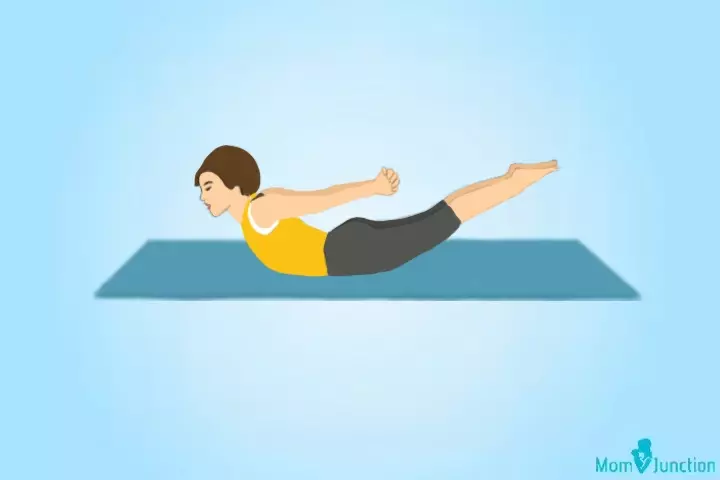
This backbend helps children by strengthening the back, glutes, and leg muscles while stretching the front of the body.
How to do:
- Lie on your belly or stomach.
- Position your arms beside your body, with either your forehead or chin resting on the mat.
- Lengthen the lower back by gently pressing the pubic bone into the floor. Pull the navel toward the spine while exhaling.
- Engage the leg muscles.
- As you inhale, lift your head, chest, arms, and legs off the floor, drawing your shoulder blades together and broadening your chest.
- Keep your feet drawn toward the midline but hip-width apart.
- Stay in this position for 5 breaths, ensuring that your breathing remains calm and steady.
- Exhale and lower your body to exit the pose, then repeat another two times.
Possible benefits: Strengthens the back, glutes, and leg muscles; stretches the front of the body; opens the chest and shoulders; stimulates the abdominal organs.
Caution: Avoid crunching the neck; keep the chin slightly in and the back of the neck long. If there’s discomfort in the hips or pubic bone, place a folded blanket under the hip bones.
42. Lotus Mudra (Pankaja Mudra)

This graceful hand gesture helps open the heart center and has soothing effects on the body and mind.
How to do:
- Sit comfortably with your back straight.
- Bring your hands together in front of your heart center.
- Point your thumbs inward toward your chest, and let the palms, thumbs, and little fingers touch.
- Spread your index, middle, and ring fingers wide, resembling a lotus flower in bloom.
- Hold this position for as long as comfortable, taking deep, calm breaths.
Possible benefits: Purifies the body; relaxes and stabilizes the mind; fosters a more loving attitude toward others.
Caution: If children feel any discomfort or strain, encourage them to relax and try again gently.
43. Lunge Pose (Banarasana)
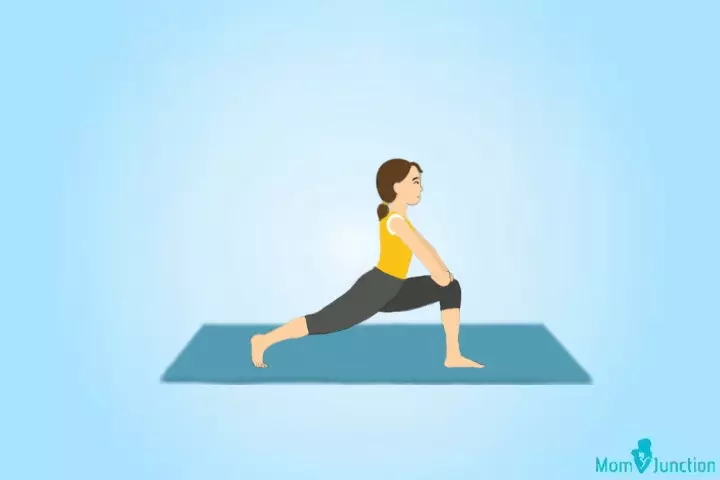
The Lunge Pose, known as Banarasana in yoga, is a fundamental pose that allows children to concentrate and stretch various muscles in the legs and hips.
How to do:
- Begin on your hands and knees in the tabletop position.
- Step your left foot forward, placing it between your hands. Ensure your left knee is directly above the ankle, forming a right angle with the floor.
- Extend your right leg straight back, with the knee and the top of the foot on the ground.
- Keep your neck in a neutral position, aligned with your spine, and gaze downward.
- Once your legs are in position, lengthen them in opposite directions: the left thigh forward and the right thigh back.
- Slowly lower your hips towards the floor to intensify the stretch in the hip flexors.
Possible benefits: Opens up the hips; stretches the psoas, hamstrings, and quadriceps; lengthens the lower back; enhances determination.
Caution: Avoid this pose if your child has neck, back, shoulder, or leg injuries. This pose is not recommended for children with poorly controlled blood pressure issues.
44. Pigeon Pose (Kapotasana)

This calming hip opener helps release tightness in the children’s hips and prepares the body for seated positions.
How to do:
- Start on all fours in a tabletop position, with hands aligned under the shoulders and knees aligned under the hips.
- Slide the right knee forward so it sits just behind the right hand, placing the outer right shin and buttock on the mat.
- Keep the right knee bent and pointing forward.
- Extend the left leg straight back, allowing the top of the left knee, thigh, and ankle to rest on the floor, with the left foot facing upwards.
- Position your right heel near the left hip, and slowly lower the pelvis down.
- Inhale deeply, press the palms into the floor, extend your spine, open the shoulders and chest, and lift the sternum.
- Hold this pose, maintaining steady breaths.
- Return to the tabletop position, and repeat with the left leg forward.
Possible benefits: Opens hips; increases hip flexibility; increases circulation in the knee area; improves posture and breathing; alleviates back pain; calms the mind.
Caution: This pose is not recommended for individuals with knee injuries, recent knee or hip surgeries, spinal issues, or delicate or inflexible wrists. Seek professional guidance if unsure.
45. Plank Pose (Phalakasana)
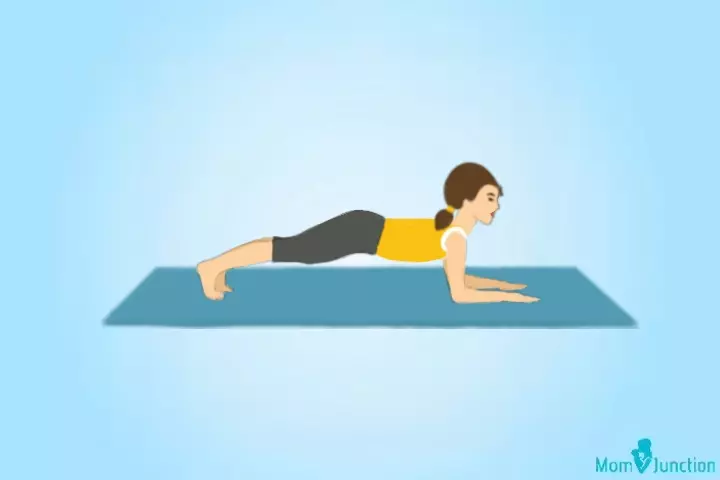
This pose will help children in strengthening and toning the entire body while enhancing core stability.
How to do:
- Start on all fours, in the table top pose.
- Position the shoulders directly over the wrists. Spread the fingers wide, with the middle fingers pointing forward.
- Press the hands firmly into the floor, keeping the upper arms engaged toward each other.
- Pull the lower belly in and up for stability.
- Straighten one leg back at a time with the toes tucked, achieving a high push-up position. The body should form a straight line from head to heels.
- Slide the shoulder blades down along the spine and press the space between them upward towards the ceiling, while drawing them into the back for support.
- Engage the thigh muscles and lengthen the tailbone towards the heels.
- Push the floor away evenly with the palms, imagining pressing the heels back against a wall.
- Squeeze the legs toward each other without moving them to increase core strength and stability.
- Look slightly forward at the floor with a relaxed jaw. Breathe evenly and steadily.
- Hold this pose for 5 breaths.
- Move back into Downward Facing Dog or gently lower the knees to the floor and rest in Child’s Pose.
Possible benefits: Develop core strength and stability; prepare the body for more advanced arm balances.
Caution: If wrists are sore, roll up a mat or towel under the heels of the hands to lessen the wrist angle.
46. Reclining Butterfly Pose (Supta Baddha Konasana)
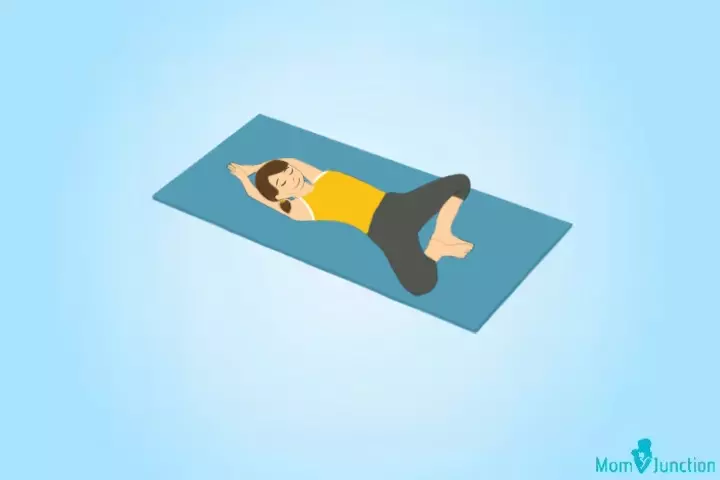
This gentle, relaxing pose helps to open up the hips and stretch the upper body.
How to do:
- Lie down flat on your back.
- Bring the soles of your feet together and let your knees drop open to form a diamond shape.
- Reach your arms overhead and hold onto opposite elbows.
- Completely relax into the pose, allowing gravity to help open up the hips.
- Hold this pose for 3-5 minutes, breathing deeply through your nose.
- To release, gently bring your hands to your knees and slowly lift them back to the center.
Possible benefits: External rotation of the hips; stretches the groin, knees, chest, and shoulders; may alleviate upper and lower back pain; improves flexibility.
Caution: Avoid this pose if your child has a hip injury.
47. Reverse Tabletop Pose (Ardha Purvottanasana)

This pose creates space in the front of the body and strengthens various muscle groups.
How to do:
- Start in a seated position.
- Bend the knees so they point upwards and place the feet flat on the floor, hip-width apart.
- Position the arms slightly behind the hips with the fingers facing towards the feet.
- Inhale, lean back slightly, and lift the hips off the ground. Ensure the knees and toes point forward.
- You can choose to gaze towards the knees, look up, or gently let the head hang back.
- Press down with the feet and arms, engaging the thighs and glutes.
- Try to elevate the hips higher.
- Hold the position for 3 to 5 breaths, then lower the hips back down on an exhale.
Possible benefits: Strengthens the neck, arms, pelvis, back,and legs; relaxes the wrists, chest, and shoulders; promotes hip stability; corrects posture.
Caution: Avoid practicing if your child has carpal tunnel syndrome, or any injuries to the neck, wrists, shoulders, back, hips, knees, or ankles, as the pose can be demanding on these areas.
48. Seated Forward Bend Pose (Paschimottanasana)
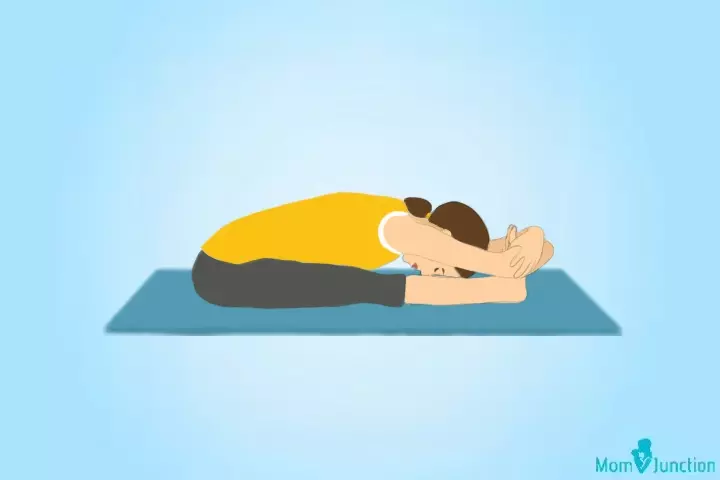
This gentle forward bend provides a deep stretch for the back and legs while calming the mind.
How to do:
- Sit with your legs extended straight in front of you.
- Keep the back straight and your toes flexed toward you.
- Inhale and lift both arms overhead, stretching upward.
- Exhale and bend forward from the hip joints, aiming to bring the chin toward the toes.
- Focus on extending forward rather than curving down towards the knees.
- Rest your hands on your legs, or if possible, hold your toes and gently pull to deepen the stretch.
- Inhale, lift the head slightly and lengthen the spine.
- Exhale, and gradually bring the navel closer to the knees.
- Repeat this stretching motion two or three times.
- Drop the head down and breathe deeply for 20-60 seconds.
- Stretch the arms forward.
- Inhale and use your arm strength to return to the sitting position.
- Exhale and lower the arms.
Possible benefits: Stretches the lower back, hips, and hamstrings; massages and tones the pelvic and abdominal organs; strengthens the shoulders.
Caution: Kids with injuries to the shoulders, pelvis, rib cage, knees, hips, or spine, or who have had recent abdominal or hip surgery, should avoid this pose.
49. Seated Twist Pose (Vakrasana)
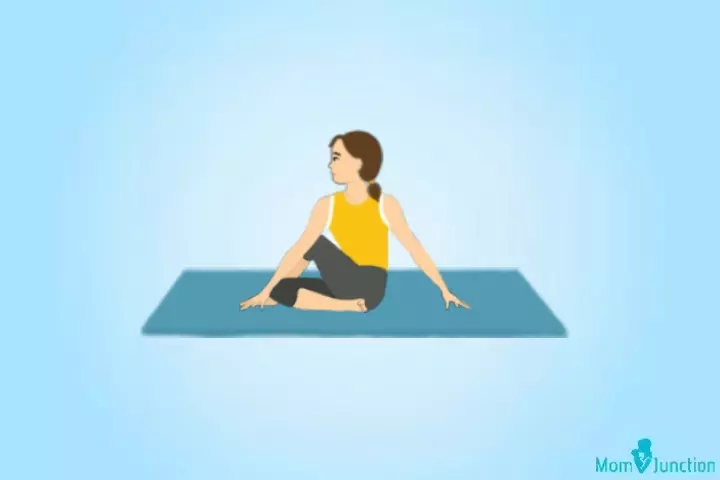
This pose with a spinal twist aids in spinal mobility and is effective for stretching and relieving pent-up tension in different parts of the upper body.
How to do:
- Sit on the floor with legs extended straight in front.
- Position the hands on the floor behind the back, fingers pointing outward.
- Place the left foot flat on the ground, on the outside of the right knee.
- Inhale, lifting the right arm up.
- Exhale, lowering the right arm, and place the elbow on the outside of the left knee.
- Rotate the chest, head, and eyes to the left.
- Hold this position for about a minute while breathing steadily.
- Gradually return the head and then the chest to the center.
- Repeat on the other side.
Possible benefits: Enhances spinal mobility; stretches the neck, shoulders, chest, upper and lower back; opens the hips; improves posture; may help in reducing upper back and neck pain.
Caution: Avoid this pose if your child has a spinal injury, recent surgery, or acute pain in the shoulders or knees.
50. Squat Pose (Malasana)
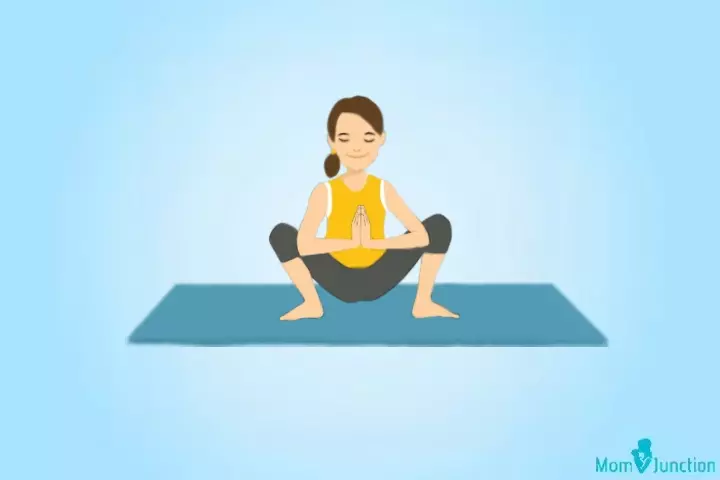
This squat pose is ideal for enhancing hip flexibility and strengthening the feet and ankles.
How to do:
- Stand up right and position your feet at shoulder-width apart.
- Lower your hips by bending your knees as if you’re going to sit on a chair.
- Unlike a conventional squat that stops at 90 degrees, keep dropping your hips lower.
- Lower your hips until your tailbone is nestled between your ankles.
- Use your elbows to press against your inner thighs, keeping your hands together in a prayer position.
- Keep your chest lifted and your shoulders back to avoid slouching.
- Let your child stay in this squat for about 30 seconds, breathing slowly.
Possible benefits: Opens the hips; stretches the groin, knees, calves, glutes, and ankles; strengthens the feet; may help alleviate lower back pain.
Caution: Avoid this pose if your child has any injuries in the ankle, hip, or knee areas.
Safety Measures To Take While Doing Yoga
Practicing yoga with children can be fun and beneficial. However, to prevent injuries, yoga should be practiced with great care and under the guidance of an expert. Here are some important safety tips to remember when practicing yoga with your child.
- Use a non-slip yoga mat to prevent slipping or falling when performing the poses. Look for a mat with good grip and thickness. Mats made of natural rubber are non-slip and eco-friendly.
- Practice yoga in an open and spacious area free from sharp objects, furniture, or anything that could cause injury. Performing yoga in spacious places encourages a full range of movement, allowing children to stretch and move through poses without feeling restricted.
- Always start with gentle stretches or a warm-up routine to prepare the body for the poses and prevent muscle strain. Focus on kid-friendly yoga asanas and avoid complex poses, especially if you and your child are beginners.
- Avoid sudden or jerky movements when performing a yoga pose. It will help prevent injury and foster a deeper connection with the body during yoga.
- Do not encourage your child to perform yoga in your absence or without the supervision of an adult. Children may not always understand their body’s limits or how to properly align themselves in a pose, which could lead to injury if performed incorrectly.
- Offer modifications if your child finds certain poses difficult. It will help accommodate their limitations while still maintaining the benefits of the activity. You may also use some props, such as blocks, straps, and blankets for support and better alignment.
- Wear well-fit, comfortable clothing that allows free movement. Clothes made from cotton or spandex are a good choice as they are soft and stretchy. Cotton, in particular, is a great choice as it also has moisture-wicking properties.
- Don’t let kids do yoga if they are sick. Consult a pediatrician if the child has any pre-existing medical conditions (13). Children with epilepsy should avoid fast breathing exercises, whereas those with back or heart problems should skip certain poses.
- Avoid pressuring your child to perfect a pose. Instead, encourage them to focus on enjoying the whole process. Lead by example and show your child that it’s okay to make mistakes. It will help them feel more comfortable with the process.
Insightful Facts About Yoga For Kids
Here are some interesting tidbits about yoga’s history, origins, and its positive impact on young minds and bodies (5) (6) (7):
- Yoga originated in ancient India over 5,000 years ago.
- The word ‘yoga’ first appeared in the Rig Veda, an ancient Indian text from around 1500 BC.
- Yoga comes from the Sanskrit word ‘yuj’, meaning ‘to join’ or ‘to unite’.
- Yoga is classified into 4 types: Bhakti Yoga, Gnana Yoga, Karma Yoga,and Kriya Yoga.
- Lord Shiva is considered the first yogi and shared his knowledge with seven sages, who spread it across the world.
- Swami Vivekananda introduced the Yoga Sutras to the West, outlining the principles and practices of yoga.
- June 21st is celebrated as the International Yoga Day to promote yoga’s benefits worldwide.
- Rishikesh in India is known as the ‘yoga capital of the world,’ and attracts visitors from different parts of the world.
Frequently Asked Questions
1. How can yoga help children with body awareness and coordination?
Yoga involves the use of various minor movements, balanced oppositional muscular workouts, postural adjustments, and repeated practice of eye-hand coordination, all of which can help increase bodily awareness and coordination in children (8).
2. Can yoga help build self-confidence and self-esteem in children?
Postural manipulation, balance and control over the body can help improve self-confidence in children (8). Furthermore, research suggests that practicing yoga is associated with enhanced self-esteem in school children (9).
3. How does yoga encourage children’s creativity and imagination?
Yoga involves various poses and sequences to encourage children to explore and express themselves through movement, which boosts their imagination and creativity. It also promotes a strong mind-body connection, allowing them to tap into their creative and imaginative abilities. Furthermore, it involves playful elements, such as animal-themed poses or incorporating props such as stuffed animals that ignite children’s imagination.
4. What are some yoga poses that can be practiced in a classroom or during a school break?
Child’s pose, mountain pose, chair pose, forward fold pose, butterfly pose, and cat-cow pose are some easy yoga poses children across ages can practice in their classroom or during the school break. Children can begin with three to five-minute sessions and gradually increase the time to ten minutes or more. Playing music and using yoga props are some creative ways schools can make yoga sessions more enjoyable for children (10).
5. How can I make yoga fun for my child?
To make yoga enjoyable for your child, integrate playful elements including stories and games. Weaving a story that incorporates various asanas or mimicking the sound of animals while doing animal poses are a few examples. Use yoga cards or videos designed for kids, incorporate their favorite songs, and practice with them to make it a bonding activity. Keeping sessions light-hearted and engaging will help maintain their interest.
6. How long should a yoga session for kids last?
A yoga session for kids should typically last around 15-20 minutes, depending on their age. Children under 6 years old can manage up to 10 seconds in the final stage of each yoga pose (11). Therefore, keeping the total session time to no more than 20 minutes helps keep them engaged without overwhelming them. Adjust the length based on their age and attention span.
7. Can yoga help with my child’s anxiety or hyperactivity?
Yoga has been shown to lower hyperactivity and improve focus, which can enhance learning and school performance. Additionally, doing yoga together as a family may help reduce anxiety and stress, manage your child’s behavior, and improve your relationship with your child (12).
8. What should my child wear for yoga?
Wearing fitted yet comfy, stretchy clothes like leggings, shorts, and t-shirts are ideal for yoga. Bare feet are best to help them balance and avoid slipping.
9. What is the right age for children to start yoga?
Children can generally begin practicing yoga at around five years, though there’s no strict universal consensus on the ideal starting age (13). By this age, children have enough body awareness and can understand simple instructions. Start with easy poses, breathing exercises, and fun movements instead of complicated postures.
Yoga is a holistic approach that helps establish a balance between the mind, body, and soul. The above yoga poses for kids may help to keep them disciplined, calm, focused, and, more importantly, to help them maintain emotional stability. Start with one or two simple poses to let your child build their core strength and stamina. Then, you can teach them complex poses based on their interest and body flexibility. Encourage your child to practice yoga regularly to help them lead a healthier, happier, and peaceful life.
Illustration: Best Yoga Poses For Kids

Image: Stable Diffusion/MomJunction Design Team
Yoga is a good form of physical activity at any age. Show your kids this fun and imaginative video to help explore different yoga poses for kids.
References
- Ingunn Hagen, and Usha S. Nayar; (2014); Yoga for Children and Young People’s Mental Health and Well-Being: Research Review and Reflections on the Mental Health Potentials of Yoga.
https://www.ncbi.nlm.nih.gov/pmc/articles/PMC3980104/ - Michelle Mochan; (2017); The Benefits of Teaching Yoga to Young Children with Special Needs: Developing an Appropriate Methodology.
https://infonomics-society.org/wp-content/uploads/ijtie/published-papers/volume-6-2017/The-Benefits-of-Teaching-Yoga-to-Young-Children-with-Special-Needs.pdf - More Than Just A Game: Yoga For School-Age Children.
https://www.health.harvard.edu/blog/more-than-just-a-game-yoga-for-school-age-children-201601299055 - Amit Kauts and Neelam Sharma; (2009); Effect of yoga on academic performance in relation to stress.
https://www.ncbi.nlm.nih.gov/pmc/articles/PMC3017967/ - A Brief History Of Yoga: Through the ages.
https://www.artofliving.org/in-en/yoga/beginners/brief-history-yoga - Rishikesh.
https://uttarakhandtourism.gov.in/destination/rishikesh - Yoga.
https://isha.sadhguru.org/yoga/ - Benefits of Yoga in Daily Life.
https://www.bkmedicalwing.org/benefits-of-yoga-in-daily-life/ - Bhardwaj Abhishek and Agrawal Gaurav; (2013); Yoga Practice Enhances the Self Esteem in Preadolscent School Children.
https://www.indianjournals.com/ijor.aspx?target=ijor:ijpss&volume=3&issue=10&article=017 - Yoga For Children.
https://www.actionforhealthykids.org/activity/yoga-and-mindfulness/ - Yoga for Children of the Age group 3-6 years.
https://wcd.nic.in/poshan/NNM-Web-Contents/LEFT-MENU/Guidelines/Yoga_for_Children_of_age_3-6_years_English.pdf - Luxhman Gunaseelan et al; (2025); Yoga for the Management of Attention-Deficit/Hyperactivity Disorder.
https://www.ncbi.nlm.nih.gov/pmc/articles/PMC8760933/ - Yoga for Children.
https://iapindia.org/pdf/Ch-104-Yoga-for-Children-IAP-Parental-Guidelines-02122021.pdf - Yoga for kids – Easy Yoga Poses for Kids.
https://www.artofliving.org/in-en/yoga/beginners/easy-yoga-for-kids
Community Experiences
Join the conversation and become a part of our nurturing community! Share your stories, experiences, and insights to connect with fellow parents.
Read full bio of Dr. Sandeep Jassal
- Dr. Wendy Schofer is a board-certified pediatrician and lifestyle physician, registered yoga teacher, and certified life and health coach. After serving as a pediatrician and primary care medical officer with the US Navy, she founded her private practice Family in Focus in Chesapeake, Virginia. She did her residency in Pediatrics at Naval Medical Center San Diego and has over 13 years of experience as a pediatrician.
 Dr. Wendy Schofer is a board-certified pediatrician and lifestyle physician, registered yoga teacher, and certified life and health coach. After serving as a pediatrician and primary care medical officer with the US Navy, she founded her private practice Family in Focus in Chesapeake, Virginia. She did her residency in Pediatrics at Naval Medical Center San Diego and has over 13 years of experience as a pediatrician.
Dr. Wendy Schofer is a board-certified pediatrician and lifestyle physician, registered yoga teacher, and certified life and health coach. After serving as a pediatrician and primary care medical officer with the US Navy, she founded her private practice Family in Focus in Chesapeake, Virginia. She did her residency in Pediatrics at Naval Medical Center San Diego and has over 13 years of experience as a pediatrician.
Read full bio of sanjana lagudu
Read full bio of Swati Patwal
Read full bio of Dr. Joyani Das







